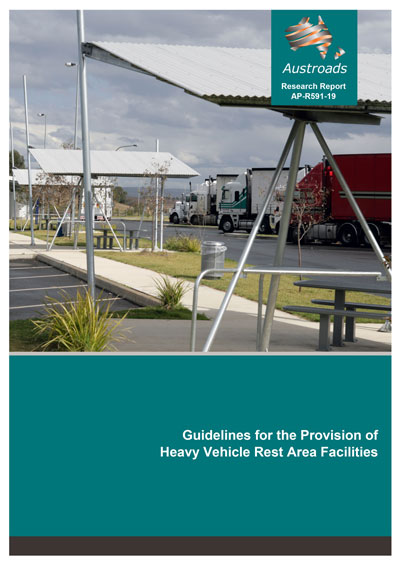Freight

- Publication no: AP-R591-19
- ISBN: 978-1-925854-33-6
- Published: 16 July 2019
- Edition: 1.1
- PDF (free) Download
Heavy vehicle rest areas (HVRAs) are provided to help heavy vehicle drivers manage fatigue and comply with driving hours regulation.
To aid road managers in this task, Austroads has produced Guidelines for the Provision of Heavy Vehicle Rest Area Facilities.
This document draws on and provides an update to the 2005 National Transport Commission Guidelines. It also incorporates guidance outlined in ‘A Proposed HVRA Needs and Prioritisation Methodology’, published by Austroads in 2012. This document supersedes those two documents.
Edition 1.1 has been updated to include new guidance relating to heavy vehicles transporting dangerous goods, capacity of HVRA to accommodate Oversize/Overmass (OSOM) vehicles, as well as additional minor amendments.
Note
Transport Certification Australia (TCA) is progressively releasing digitised informal rest area information through their Traveller Information Exchange (TIX).
The webinar, held on 14 February 2019, provides an overview of the guidelines.
Edition 1.1 has been updated to include new guidance relating to heavy vehicles transporting dangerous goods, capacity of HVRA to accommodate Oversize/Overmass (OSOM) vehicles, as well as additional minor amendments.
- Summary
- 1. Introduction
- 1.1 Context
- 1.2 Background
- 1.3 Purpose of the Guidelines
- 1.4 How to Use the Guidelines
- 1.4.1 Mapping HVRA Classification Terminology
- 2. Types of HVRAs
- 3. Assessing Need and Prioritisation for HVRAs
- 3.1 HVRA Strategy
- 3.2 Assessing the Need for Expansion/Upgrade or New HVRAs
- 3.3 Prioritising the Establishment or Upgrade of HVRAs
- 3.4 Assessing the Need for HVRAs Along New Sections of Road
- 4. Principles of Good HVRA Design
- 4.1 Overview
- 4.2 Types of HVRAs
- 4.2.1 Formal HVRAs
- 4.2.2 Informal HVRAs
- 4.2.3 Other Rest Opportunities
- 4.3 Spacing and Placement of HVRA
- 4.3.1 Spacing
- 4.3.2 Placement
- 4.4 Key Safety Features
- 4.4.1 Safe Vehicle Movement and Access
- 4.4.2 Capacity and Parking Bay Size
- 4.4.3 Separation of Light and Heavy Vehicles
- 4.4.4 Separation of Vehicles Carrying Noisy Freight
- 4.4.5 Separation for Long-term and Short-term Users
- 4.4.6 Unidirectional Flow
- 4.4.7 No Reversing Movements
- 4.4.8 Security
- 4.4.9 Pedestrian Safety and Access
- 4.4.10 Signage on Approach and Within HVRAs
- 4.5 Amenities/Extras
- 4.5.1 All-weather Seal
- 4.5.2 Tables/Benches
- 4.5.3 Natural Shade
- 4.5.4 Shelter
- 4.5.5 Rubbish Bins
- 4.5.6 Lighting
- 4.5.7 Toilets
- 4.5.8 Water
- 4.5.9 Visitor Information Board
- 4.5.10 Managed Livestock Effluent Disposal Sites
- 4.6 Additional Issues
- 4.6.1 Parking Bay Orientation
- 4.6.2 Providing for People with a Disability or Mobility Difficulty
- 4.6.3 Ongoing Maintenance
- 4.6.4 Ensuring Availability of HVRAs for Heavy Vehicle Drivers
- 4.6.5 Provision for Coupling and Decoupling
- 4.6.6 Use of HVRAs by Light Vehicle Drivers
- 4.6.7 Cross-border Compatibility
- 4.6.8 Consideration for Future Demands
- 4.6.9 Dangerous Goods Vehicles
- 5. Communicating Rest Opportunities to Drivers
- References
- Bibliography
- Appendix A Gippsland Safe Freight Network
- Appendix B NHVR Heavy Vehicle Safety Initiative
- Appendix C HVRA Layout Schematics
- C.1 Class 1 HVRA
- C.2 Class 2 HVRA
- C.3 Class 3 and 4 HVRA
- C.4 Class 5 HVRA
- C.5 Informal HVRA
- Appendix D Assessing Heavy Vehicle Crash Rates
- Appendix E TCA Mapping of HVRAs
- Appendix F Estimating Parking Spaces
- Glossary
